Yakisoba
This post may contain affiliate links. Read my full disclosure policy.
Whip up some yakisoba tonight! Stir-fried Japanese noodles mixed with savory meat, fresh veggies, and a tasty sauce make the perfect quick-fix dinner.
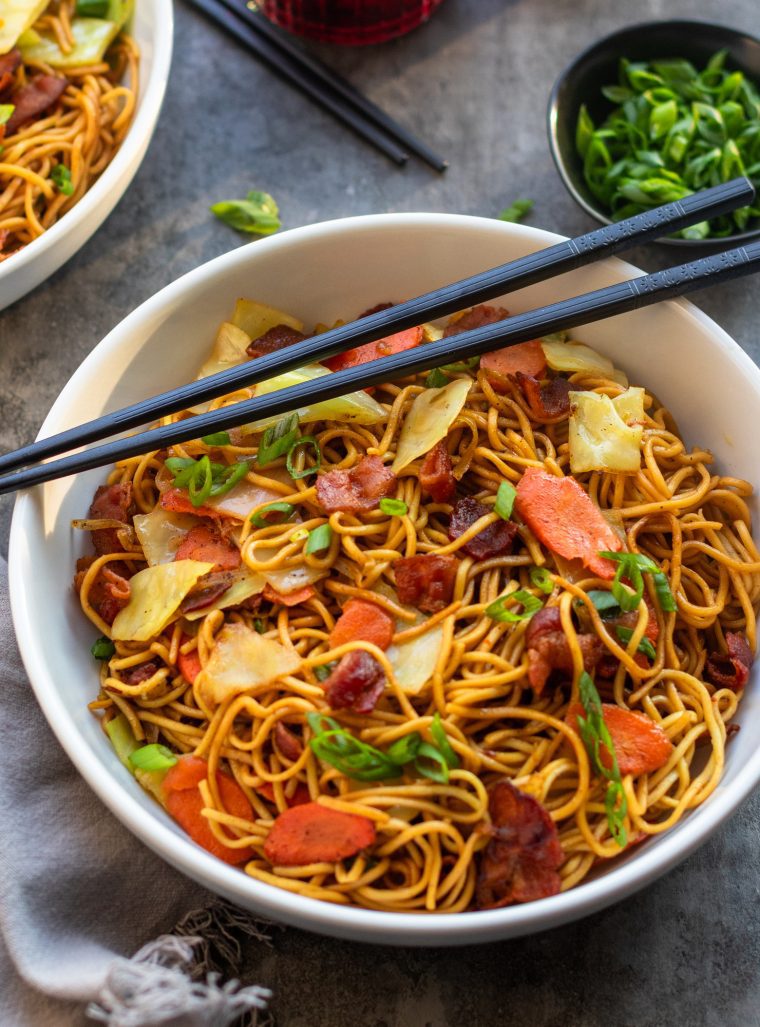
Yakisoba noodles are a popular Japanese dish, enjoyed everywhere from the bustling yatai (street food stalls) to the comfort of home kitchens. These stir-fried noodles marry a variety of ingredients like pork, cabbage, onions, and carrots with a savory yet slightly sweet sauce with a distinct Worcestershire flavor—yes, Worcestershire sauce is indeed used in Japanese cooking! It’s a versatile one-skillet dish that makes a quick and satisfying supper.
Adapted from Make It Japanese: Simple Recipes for Everyone by Rie McClenny, this yakisoba recipe is not only delicious but also practical. By using bacon instead of the traditional thinly sliced pork belly, it’s easy to gather all the ingredients from your local supermarket without compromising on flavor. This smart swap aligns with the mission of the book: to make Japanese cooking accessible for anyone, anywhere.
Table of Contents
What You’ll Need To Make Yakisoba
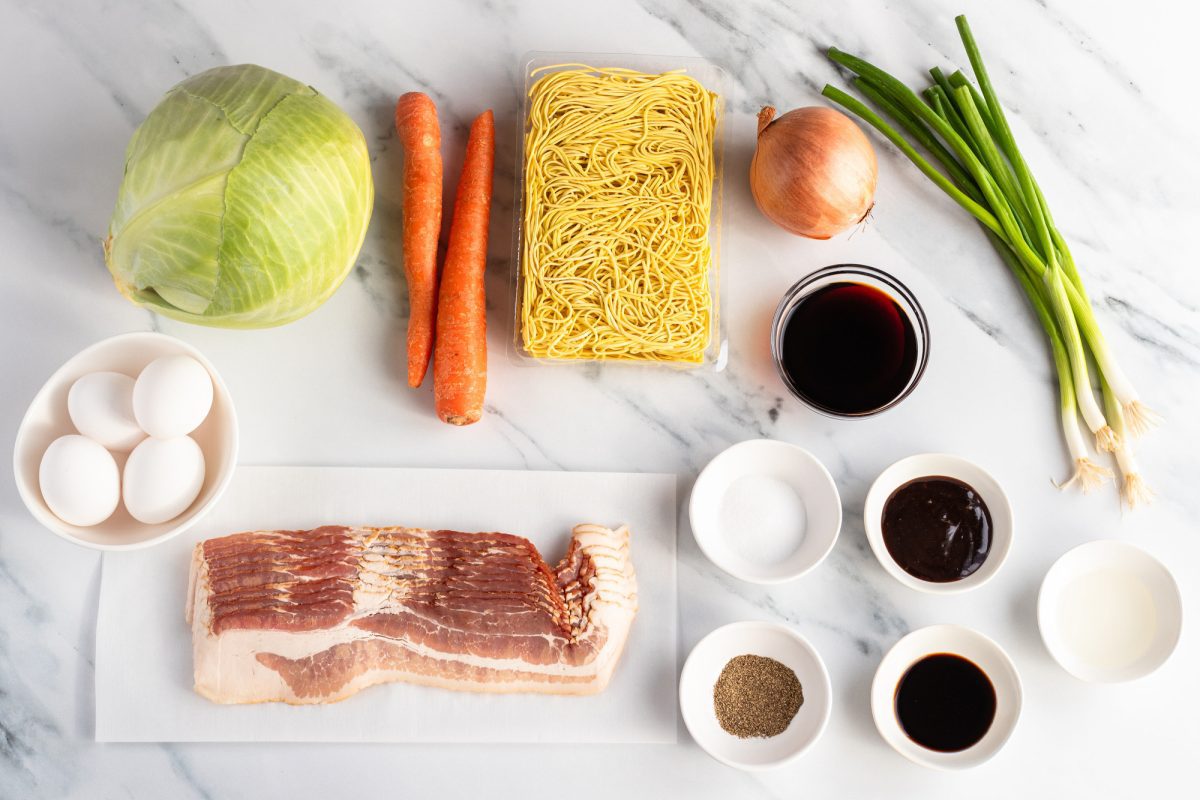
- Yakisoba noodles: While fresh yakisoba noodles are ideal, they can be hard to come by. Dried chow mein stir-fry noodles make an excellent substitute. You can also use spaghetti. Remember, if using dried noodles, you’ll need about half the amount in weight.
- Soy sauce: This is the base of the sauce, providing essential umami and salty flavors.
- Worcestershire sauce: Adds a tangy depth to the sauce, contributing to the dish’s distinctive flavor.
- Mirin: This sweet Japanese cooking wine sweetens the sauce, balancing the saltiness and tang.
- Hoisin sauce: Enhances the sauce with a sweet and garlicky flavor.
- Bacon: Acts as the protein element in the dish, offering a smoky, hearty addition.
- Scallions: The white parts flavor the dish while the green parts are used for garnish, adding a fresh, oniony touch.
- Carrots: Add sweet flavor and crunch, brightening the dish.
- Yellow onion: Contributes sweetness and texture.
- Green cabbage: Adds volume and a fresh crunch. If you want to skip chopping a whole cabbage, pre-shredded coleslaw makes a quick substitute.
- Fried eggs: Optional but recommended, the runny yolks add delicious richness to the sauce. (See my simple technique for making sunny side up eggs.)
- Jump to the printable recipe for precise measurements
Step-by-Step Instructions
Step 1: Cook the Noodles (if using dried noodles)
If using fresh noodles, skip this step. If using dried noodles, bring a large pot of water to a boil. Cook the noodles until very al dente. Drain and rinse with cold water to stop the cooking process.
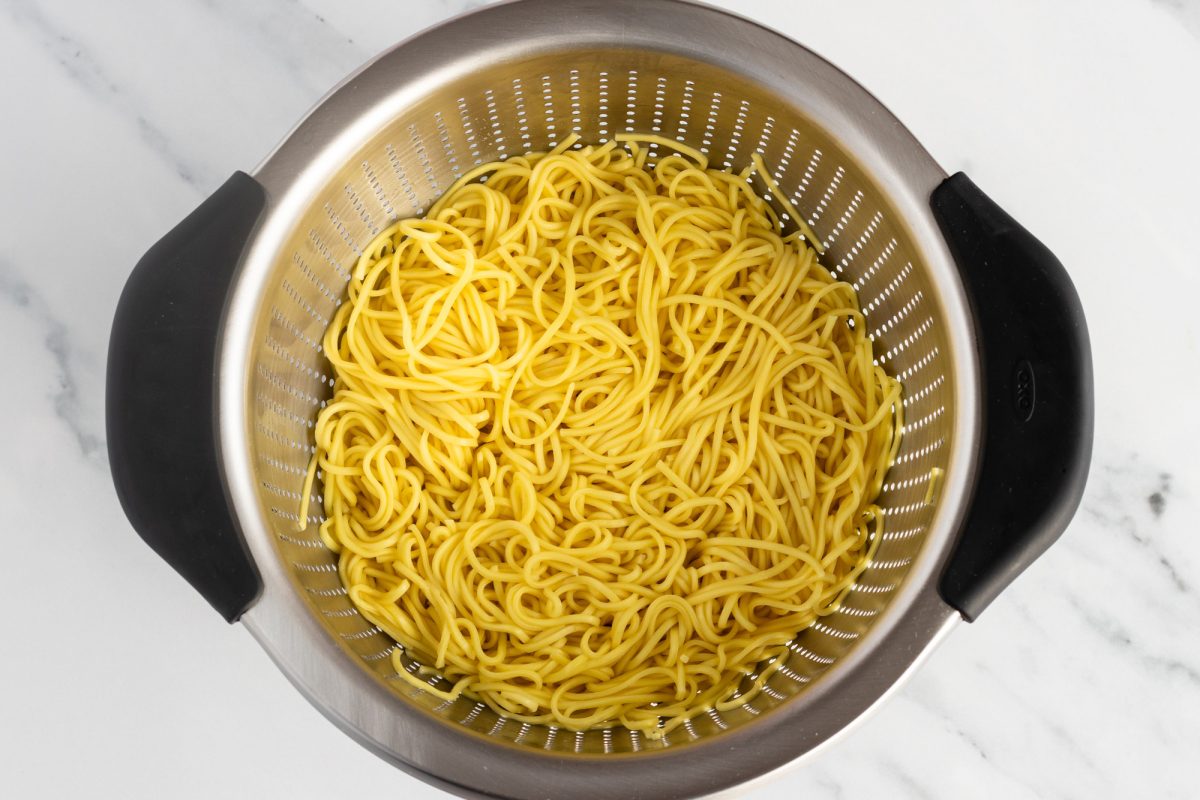
Step 2: Make the Yakisoba Sauce
In a small bowl, whisk together the soy sauce, Worcestershire, mirin, and hoisin sauce.
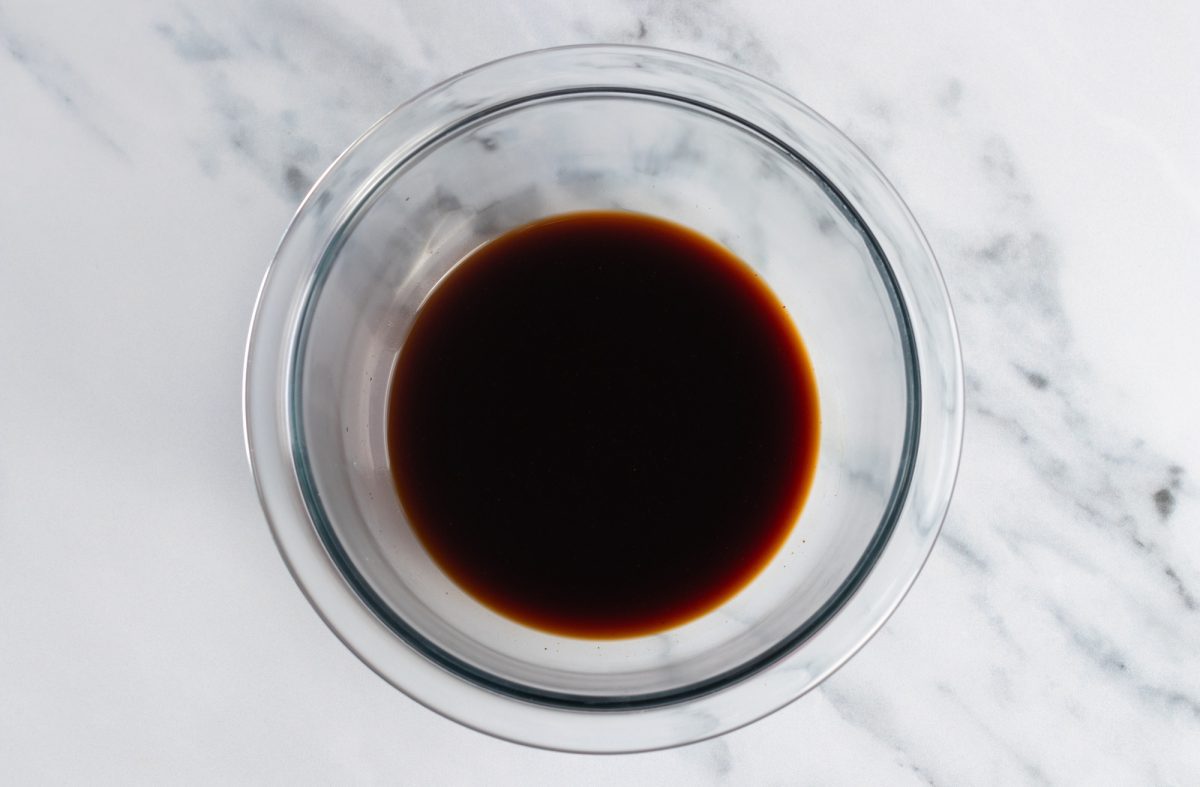
Step 3: Make the Stir-Fry
Add the bacon to a cold nonstick skillet. Turn the heat to medium high and cook, stirring frequently, until the bacon is crispy, 4 to 5 minutes. Using a slotted spoon, transfer the bacon to a medium bowl, leaving the fat in the skillet.
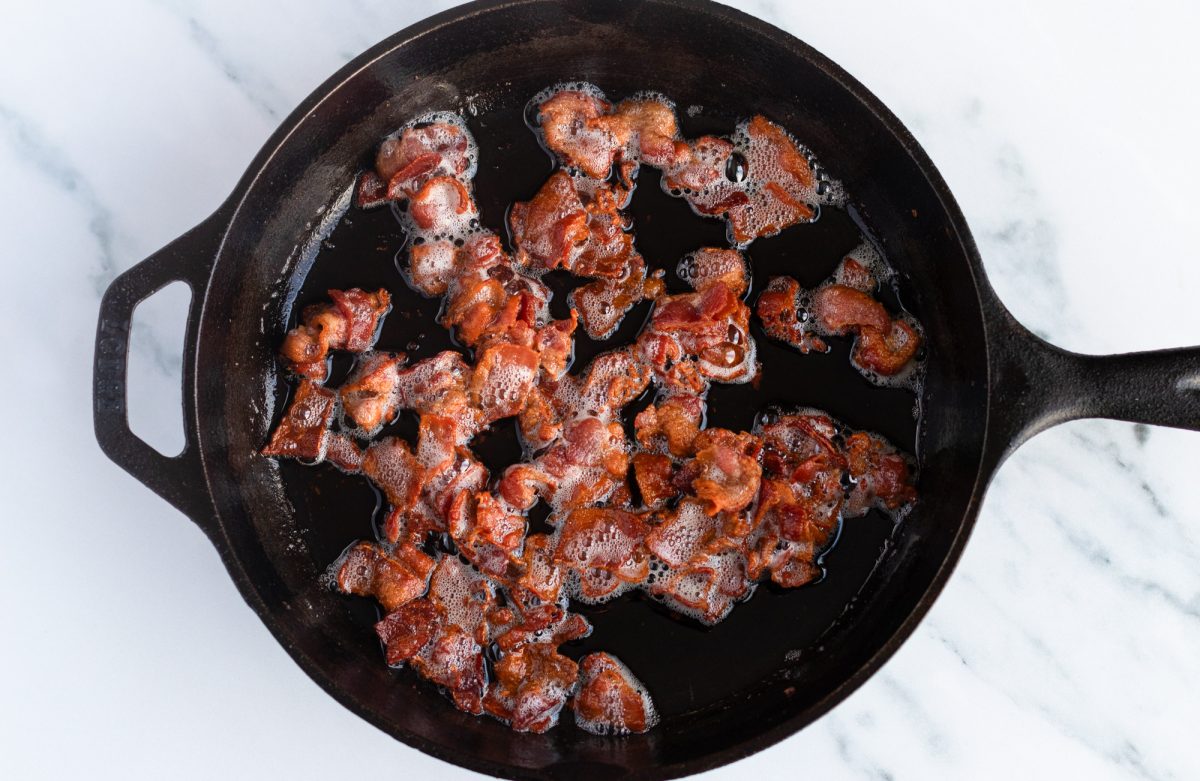
To the same skillet, add the scallion whites, carrots, and onion.
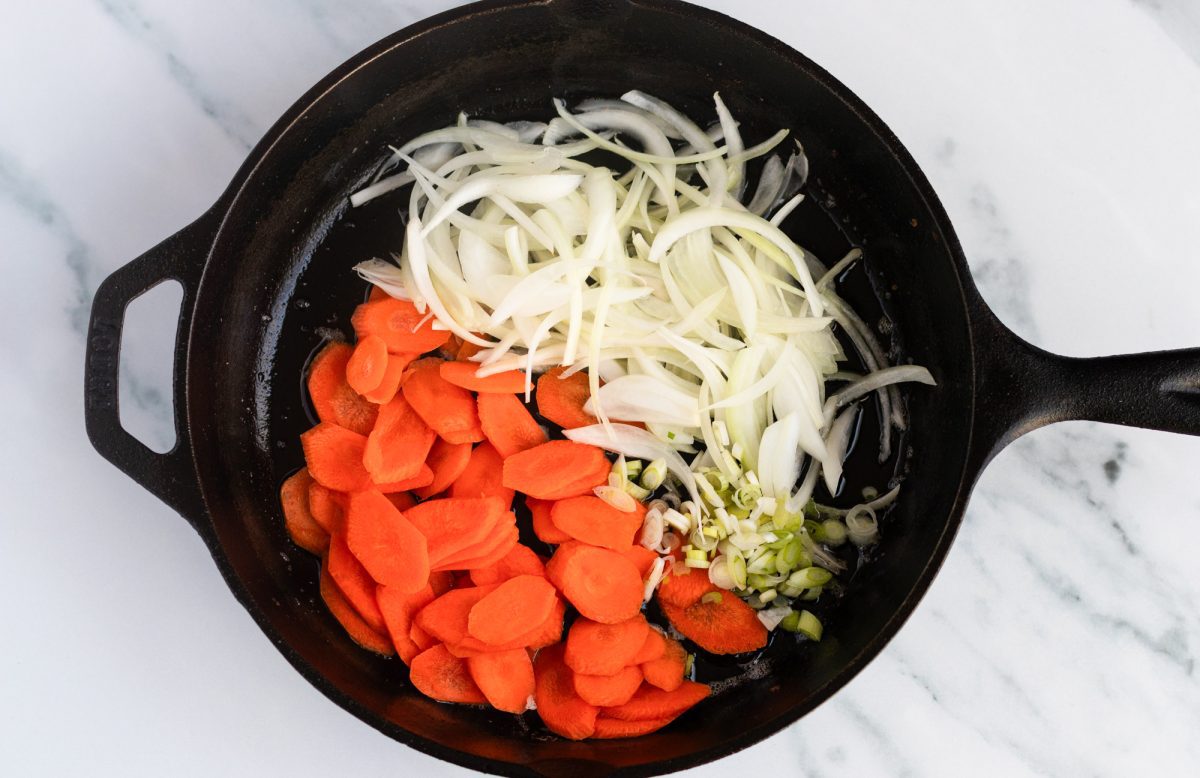
Cook until the onion is translucent, 3 to 4 minutes. Do not brown; reduce heat if necessary.
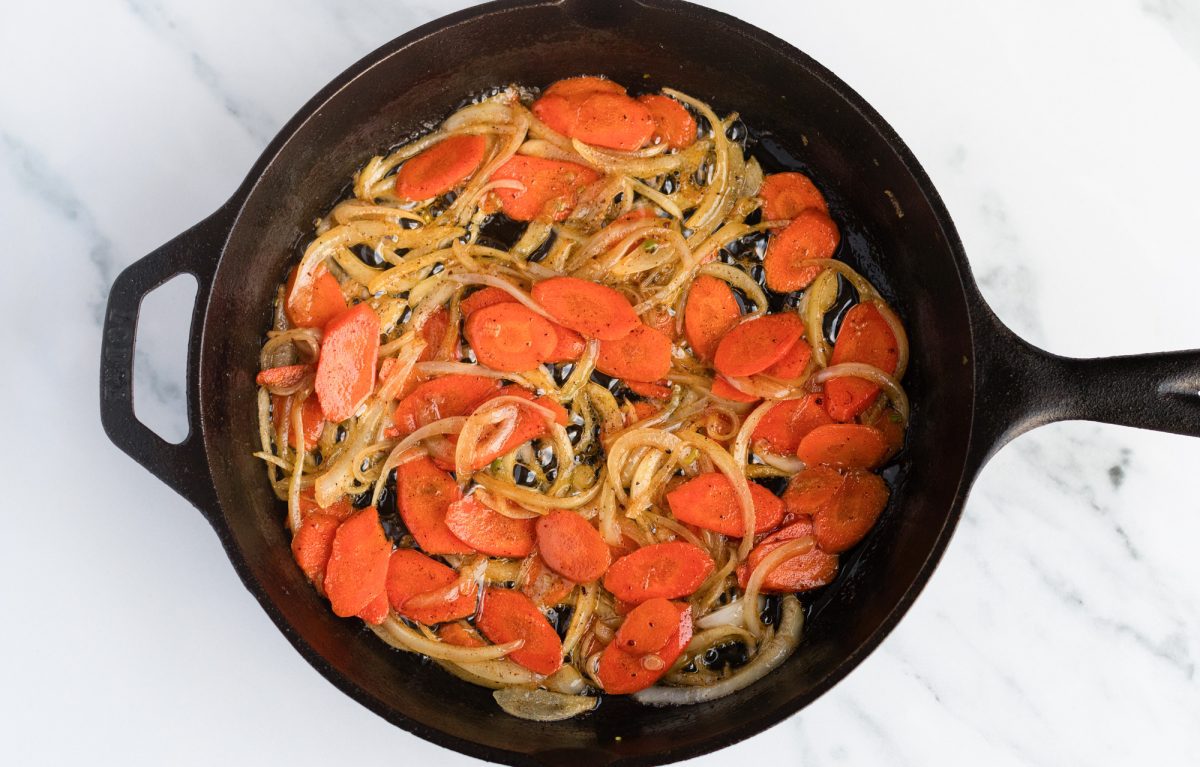
Add the cabbage and cook until soft, about 4 minutes. Season with the salt and pepper. Transfer the vegetables to the bowl with the bacon.
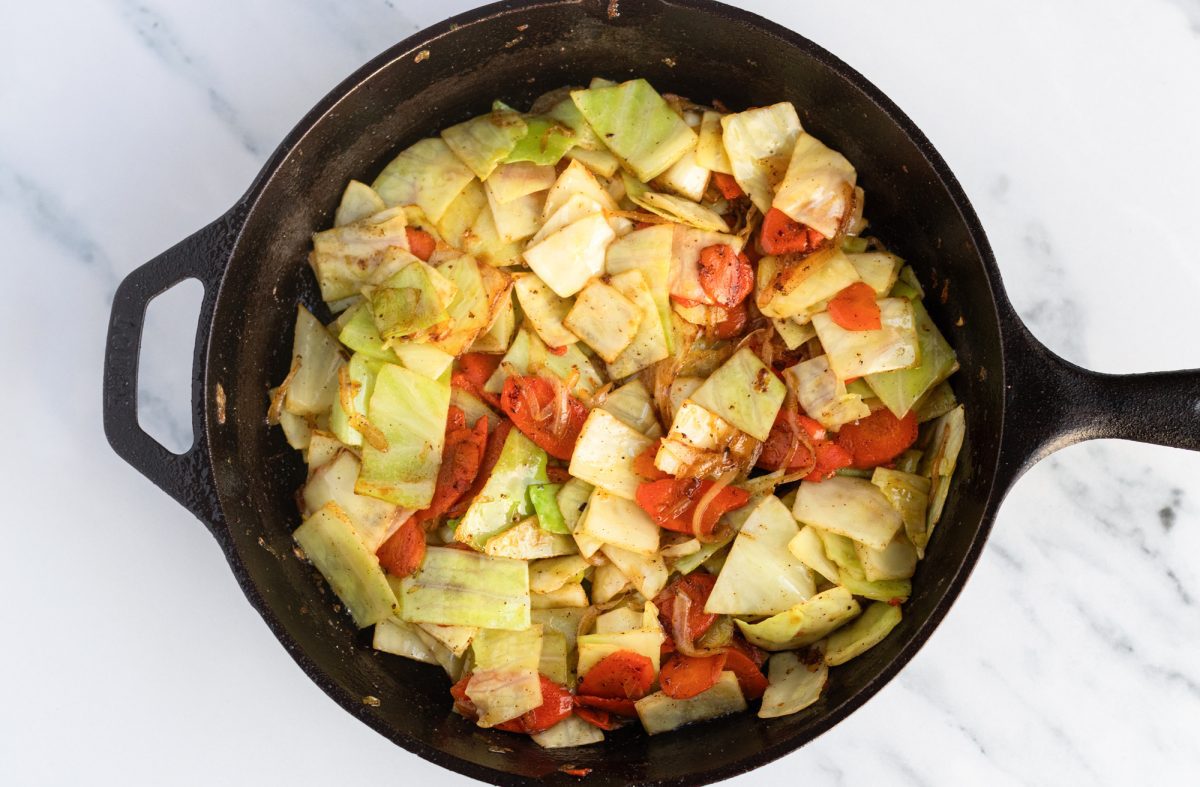
To the now empty skillet, add the drained noodles. Cook for a few minutes, until warmed through. Add about half of yakisoba sauce to the noodles and toss until evenly coated.
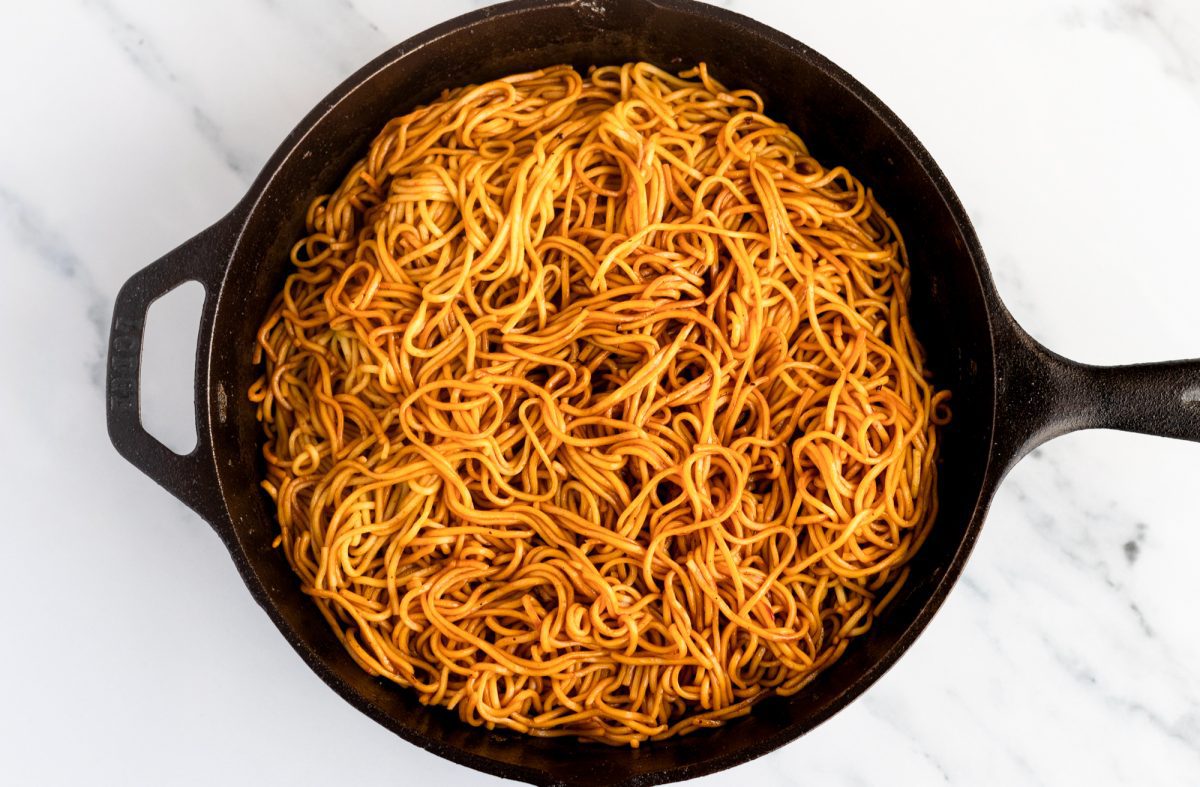
Return the vegetables and bacon to the skillet and toss to combine. Taste the dish, and if more flavor is needed, add the remaining sauce little by little; you may not need all of it. Sprinkle with the dark green scallions. Sprinkle with the dark green scallions.
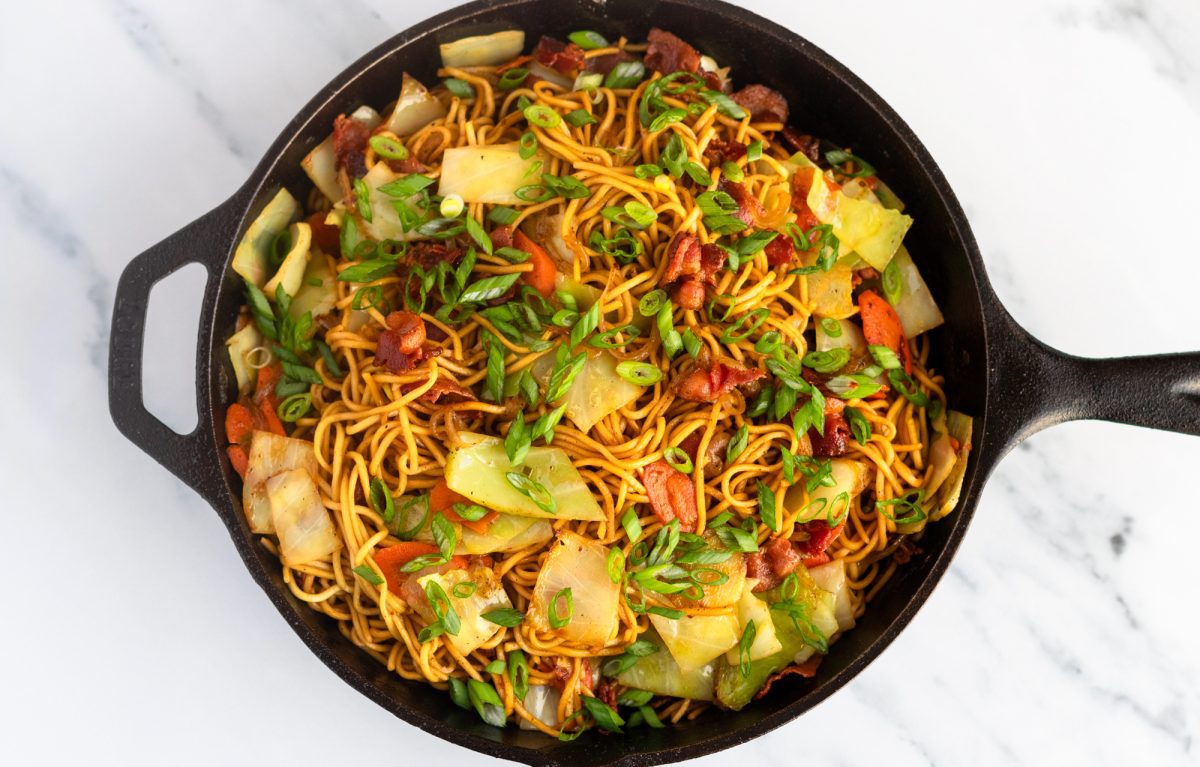
If you’re including optional fried eggs, now’s the time to cook them in a separate nonstick skillet. Once done, divide the yakisoba among bowls and place a fried egg on top of each serving, if using.
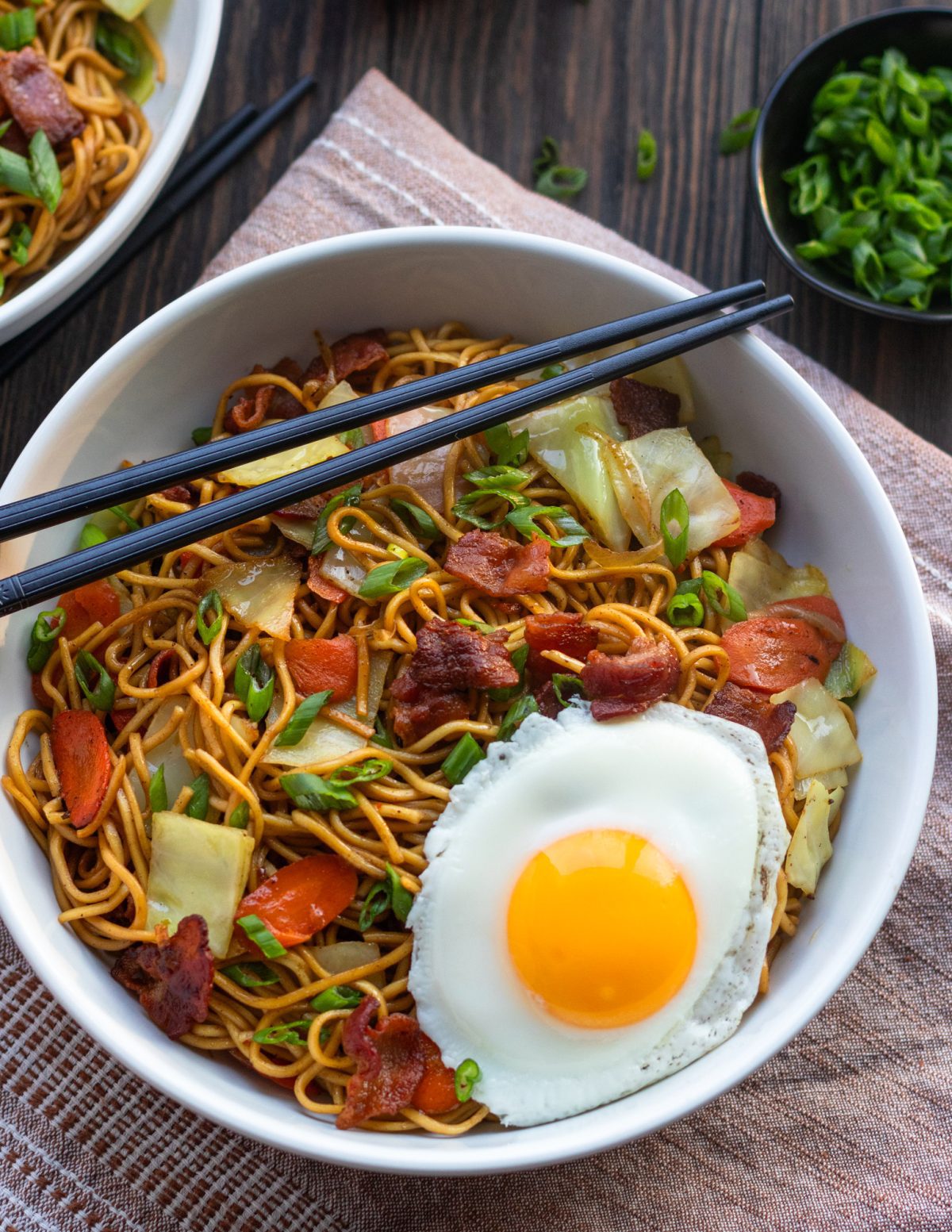
Frequently Asked Questions
While best served fresh, yakisoba can be cooked in advance and refrigerated. Just keep in mind that the bacon will lose its crispy texture if not served fresh. When reheating, warm the dish in a skillet over medium heat or in the microwave, adding a bit of water to loosen up the noodles if necessary.
While thinly sliced pork belly is traditional and bacon adds a distinctive flavor in this specific recipe, you can switch it out for other proteins like chicken, shrimp, or tofu. Since these alternatives are leaner than bacon, they should be cooked in a few tablespoons of oil to ensure they don’t stick to the pan. Once fully cooked, you can then add them to the dish along with the noodles and vegetables, similar to the bacon.
Fresh yakisoba noodles can be found in the refrigerated or frozen section of Asian supermarkets. I can’t find them easily where I live, so I use dried chow mein noodles instead. You can also use spaghetti. Note that if using dried noodles, you’ll typically need about half the amount in weight compared to fresh. Simply cook the dried noodles according to the package instructions before adding them to the yakisoba.
You May Also Like
Yakisoba
Whip up some yakisoba tonight! Stir-fried Japanese noodles mixed with savory meat, fresh veggies, and a tasty sauce make the perfect quick-fix dinner.
Ingredients
- 22 oz fresh yakisoba noodles or 12 oz dried chow mein stir-fry noodles (see note)
- ⅓ cup soy sauce
- 1 tablespoon Worcestershire sauce
- 1 tablespoon mirin
- 2 tablespoons hoisin sauce
- 8 slices (8 oz) bacon, cut into 1-inch pieces
- 4 scallions, white and green parts separated, thinly sliced
- 2 carrots, thinly sliced on a diagonal, about ⅛-inch thick
- 1 medium yellow onion, thinly sliced
- ½ pound green cabbage, cut into 1-inch pieces (about 3½ cups)
- ¼ teaspoon salt
- ¼ teaspoon freshly ground black pepper
- 4 fried eggs (optional for serving)
Instructions
- If using dried noodles, boil the noodles: Bring a large pot of water to a boil. Cook the noodles until very al dente. (The noodles I use call for 3 minutes of boiling; I cook them for 2½ minutes. If the timing is different on your package, reduce the time accordingly.) Drain and rinse with cold water to stop the cooking process. (If using fresh noodles, skip this step.)
- Make the Yakisoba Sauce: In a small bowl, whisk together the soy sauce, Worcestershire, mirin, and hoisin sauce.
- Make the Stir-Fry: Add the bacon to a cold nonstick skillet. Turn the heat to medium high and cook, stirring frequently, until the bacon is crispy, 4 to 5 minutes. Using a slotted spoon, transfer the bacon to a medium bowl, leaving the fat in the skillet.
- To the same skillet, add the scallion whites, carrots, and onion and cook until the onion is translucent, 3 to 4 minutes. Do not brown; reduce heat if necessary. Add the cabbage cook until soft, about 4 minutes. Season with the salt and pepper. Transfer the vegetables to the bowl with the bacon.
- To the now empty skillet, add the fresh or drained noodles. Cook for a few minutes, until warmed through. Add about half of the yakisoba sauce to the noodles and toss until evenly coated. Return the vegetables and bacon to the skillet and toss to combine. Taste the dish, and if more flavor is needed, add the remaining sauce little by little; you may not need all of it. Sprinkle with the dark green scallions.
- If you're including optional fried eggs, now's the time to cook them in a separate nonstick skillet. Once done, divide the yakisoba among bowls and place a fried egg on top of each serving, if using.
- Note: Yakisoba is traditionally made with fresh yakisoba noodles, which are available in the refrigerated section of most Asian supermarkets and some large grocery stores. Since they can be hard to find, I use dried chow mein noodles. I like the Wel Pac brand. Note that if using dried noodles, you'll typically need about half the amount in weight compared to fresh.
- Make-Ahead Instructions: While best served fresh, yakisoba can be cooked in advance and refrigerated. Just keep in mind that the bacon will lose its crispy texture if not served fresh. When reheating, warm the dish in a skillet over medium heat or in the microwave, adding a bit of water to loosen up the noodles if necessary.
Nutrition Information
Powered by ![]()
- Per serving (4 servings)
- Calories: 902
- Fat: 29 g
- Saturated fat: 9 g
- Carbohydrates: 127 g
- Sugar: 11 g
- Fiber: 9 g
- Protein: 34 g
- Sodium: 1845 mg
- Cholesterol: 169 mg
This website is written and produced for informational purposes only. I am not a certified nutritionist and the nutritional data on this site has not been evaluated or approved by a nutritionist or the Food and Drug Administration. Nutritional information is offered as a courtesy and should not be construed as a guarantee. The data is calculated through an online nutritional calculator, Edamam.com. Although I do my best to provide accurate nutritional information, these figures should be considered estimates only. Varying factors such as product types or brands purchased, natural fluctuations in fresh produce, and the way ingredients are processed change the effective nutritional information in any given recipe. Furthermore, different online calculators provide different results depending on their own nutrition fact sources and algorithms. To obtain the most accurate nutritional information in a given recipe, you should calculate the nutritional information with the actual ingredients used in your recipe, using your preferred nutrition calculator.


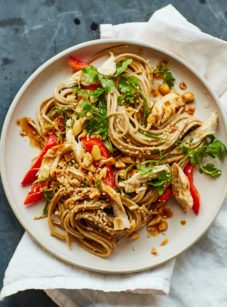
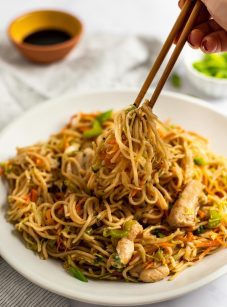
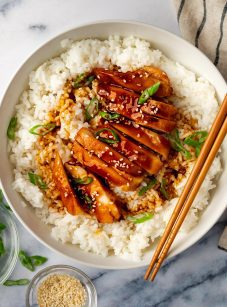
Second time making this dish and fantastic both times. This time I only had one pack of the chow mein noodles so I used half spaghetti. It worked fine but I will stock up on the recommended noodles in my pantry for this delicious meal. Thanks Jenn—your recipes are consistently fabulous!
I followed this recipe exaactly as written and it was a hit with my family. I have a very picky 6 year old and she inhaled the noodles and bacon, definately going to make it again and who knows, maybe I’ll be able to talk her into giving the cabbage a try.
I made this for the second time tonight and my husband and I both loved it! I didn’t make any changes to the recipe. Our bacon wasn’t too salty (and very lean) and added a nice flavor. Thank you for your wonderful recipes! I have been following your site for years and most of my favorite recipes are in my “Once Upon A Chef” binder(s). One added note: I really appreciate your detailed instructions. Thank you for supplying us with so many delicious options for meals- you’re the best!
💕
Always anxious to try Jenn’s latest and greatest, so I made this tonight for the two of us. Halved it with 6oz Wel-Pac chow mein noodles and used low sodium soy sauce. The ratio of noodles to veggies to sauce was spot on. I do a lot of stir fries and Asian cooking, so always looking for new ones. This was outstanding and definitely enters the rotation (as do so many of Jenn’s recipes.) Next time, with the egg!
Made this for the first time last night. Other reviews are correct about being salty-I will use low sodium soy sauce and no additional salt next time I make. The taste was awesome!! Might add chicken for more protein next time. I love to make my adult children new things when they come home and this is another to add to their next visit! Thank you @onceuponachef for your wonderful recipes!
Love the idea of this…and it was way too salty for us too – as per prior comments.
I cooked some chicken pieces marinated in ginger and garlic and a little bit of sauce and cornstarch as per a prior comment. The chicken was fabulous! The veggies were great as per your directions – just perfect! Next time, however, I will use less sauce on the yakisoba noodles – or maybe even omit the soy sauce in the mix. In the future, I will cut down on the sauce and let the noodles, chicken and veggies shine on this dish.
I so appreciate your help and expertise! It just may be that we are trying to reduce sodium and, as such, our tastebuds are changing. Doctors recommend less salt for everyone so….
Thanks so much for the feedback, Karen. Based on your comment and another the other day, I have tweaked the instructions to add the sauce gradually, to taste. You might also try low-sodium soy sauce. I think adding the eggs cuts the salt a bit, too. 🙂
I had never made (or even heard of) yakisoba, but I liked the combination of ingredients so I decided to give it a try. So glad I did! It was amazing and my family of four gobbled it up. Also, I loved that it was made in one skillet – less cleanup!
I followed the recipe exactly and just didn’t care for it. Usually Jenn’s recipes are dead on, but this one missed the mark. It was really salty. My family ate several bites and all decided it wasn’t worth it to keep eating.
Made this exactly as written and it was delicious! People are all up in arms about the bacon but it works beautifully here – if you’re worried about fat drain a little bit of it off and see how it goes. I prepped the veggies beforehand so it came together quickly. Looking forward to making this for my daughters when they visit – We live in the upper Midwest and we’re able to find all the ingredients at Meijer. Thanks Jenn for another fun, delicious recipe!
Really really good. A great alternative to sometimes boring stir fry. Changes I made was to just use red cabbage and added shiitake mushrooms. I wasn’t wild about bacon so thought about chicken or shrimp ( which could be good). My Japanese friend said “use pork!!” I bought one boneless pork loin chop ( per 2 people) and sliced thinly on angle and added at same time as veggies. Make the effort to find noodles fresh or fresh frozen as I did at a Japanese supermarket. The sauce was awesome!!